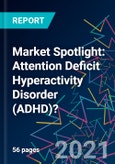This Market Spotlight report covers the Attention Deficit Hyperactivity Disorder (ADHD) market, comprising key marketed and pipeline drugs, clinical trials, recent events and analyst opinion, upcoming and regulatory events, probability of success, patent information, a 10-year disease prevalence forecast, and licensing and acquisition deals, as well as presenting drug-specific revenue forecasts.
Key Takeaways
Key Takeaways
- The publisher estimates that in 2019, there were 179.8 million prevalent cases of attention deficit hyperactivity disorder (ADHD) in people aged 5–44 years worldwide, and forecasts that number to increase to 189.0 million prevalent cases by 2028.
- The worldwide prevalence of ADHD among children aged 5–19 years is estimated to be 5.29%, while the prevalence among adults aged 20–44 years is estimated to be 2.80%.
- Approved drugs in the ADHD space target dopamine, dopamine reuptake, norepinephrine (noradrenaline), norepinephrine (noradrenaline) reuptake/transporter, and the alpha 2 adrenergic receptor. The vast majority of approved therapies are administered via the oral route.
- The highest proportion of industry-sponsored drugs in active clinical development for ADHD are in Phase II, with three drugs in the NDA/BLA stage.
- Therapies in development for ADHD focus on a wide variety of targets. The majority of pipeline drugs for ADHD are administered via the oral route, with one drug being tested in a transdermal formulation.
- High-impact upcoming events for drugs in the ADHD space comprise topline Phase IIa trial results for LSD microdose program, topline Phase III trial results for centanafadine, pivotal efficacy study results for KP484, estimated PDUFA dates for AR19 and KP415, and an expected patent expiration for Adzenys XR-ODT.
- The overall likelihood of approval of a Phase I ADHD asset is 11.8%, and the average probability a drug advances from Phase III is 73.7%. Drugs, on average, take 9.5 years from Phase I to approval, compared to 9.3 years in the overall psychiatry space.
- The distribution of clinical trials across Phase I–IV indicates that the majority of trials for ADHD have been in the late phases of development, with 54% of trials in Phase III–IV, and 46% in Phase I–II.
- The US has a substantial lead in the number of ADHD clinical trials globally. Germany leads the major European markets, while Japan has the top spot in Asia.
- Clinical trial activity in the ADHD space is dominated by completed trials. Takeda has the highest number of completed clinical trials for ADHD, with 159 trials.
- Takeda leads industry sponsors with the highest overall number of clinical trials for ADHD, followed by Eli Lilly.
Table of Contents
OVERVIEWKEY TAKEAWAYSEPIDEMIOLOGYMARKETED DRUGSPIPELINE DRUGSKEY UPCOMING EVENTSPROBABILITY OF SUCCESSREVENUE OPPORTUNITYAPPENDIX
DISEASE BACKGROUND
TREATMENT
RECENT EVENTS AND ANALYST OPINION
KEY REGULATORY EVENTS
CLINICAL TRIAL LANDSCAPE
BIBLIOGRAPHY
LIST OF FIGURES
LIST OF TABLES








